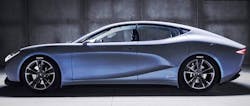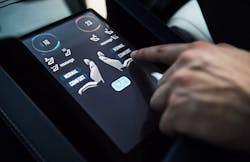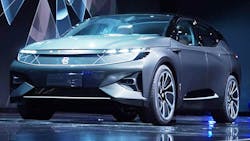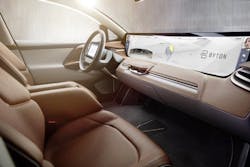China appears to be committed to having its companies at the forefront of the future of transportation. Its companies are already leaders in the emerging low-carbon economy. They own the lion’s share of the solar panel market and are among the 10 largest wind turbine manufacturers in the world.
China’s generous electric vehicle incentives enabled the world’s biggest auto market to quickly also become the world’s largest EV market. There have been rumors that they could slash those incentives, but the government instead decided to update them in order to favor longer-range cars.
One reason for China’s interest in electric vehicles is that its air is similar to the typical air in New York City or London 50 to 70 years ago. China’s government sees electric vehicles as a major solution to air pollution. In addition, it wants to minimize its dependence on foreign oil.
Among the current Chinese manufacturers of electric vehicles:
- BYD has been selling fully electric and hybrid cars in China for years, and it already has a U.S. presence for fleet and utility vehicles.
- SAIC has several pure and hybrid electric vehicles in its lineup already. It’s also partnered with the VW and GM brands in China. SAIC had 6.9 million units sold in 2016.
- FAW Group is the oldest car manufacturer in China and one of the four big legacy manufacturers. It is targeting 15% Chinese market share. It has Audi and Toyota as alliance partners in the EV and hybrid space. GM is joint ventured in one of its brands too.
- Geely owns the Volvo brand, which said it would produce only electric and hybrid cars starting in 2019. Geely itself has a fully electric car in its lineup, as well as plug-in electric hybrid vehicles.
- BAIC predicts EV sales in China will hit the one million mark in 2018. It has opened up an EV R&D center in California. It is the Chinese partner for Daimler, and the companies are jointly investing $735 million into EVs in China.
- Dongfeng was formed in 2001 and is on the Forbes Growth Champion list. It has aggressive plans globally, and specifically with regard to EVs. It has set up a joint venture with the Renault-Nissan Alliance to sell electric cars in China.
Outside of China, these companies produce EVs:
Foreign car companies doing business in China stand the risk of relinquishing their intellectual property. According to the October 17, 2017 issue of Fortune magazine:
“For foreign automakers to do business in China, they must have a joint venture with a domestic company as majority owner. The Chinese government also requires automakers to incorporate NEV (new electric vehicle) technologies in their electric vehicles if they have them. Due to these stringent requirements, foreign companies end up forfeiting their intellectual property to Chinese competitors they are forced to work with, boosting domestic Chinese industry and harming their own bottom lines in the long run.”
Chinese Start-ups
You can add LVICHI Auto to the list of Chinese companies. This Shanghai-based EV company introduced the sharp, coach-doored 992-hp four-door fastback, the Venere, at the Geneva Motor Show. The LVCHI Venere is a high-performance, all-electric four-seater conceived according to the criteria used in the design and manufacture of Gran Turismo vehicles (Fig. 1). And it is not shying away from using new technology, particularly with respect to its structure.
1. LVICHI’s all-electric four-seater, the Venere, can accelerate to 0-100 kmh in 2.5 sec. and has a maximum speed of 285 kmh.
The underlying concept in terms of structure is the frame—the central element made totally of composite material, carbon fiber sandwich, and honeycomb design—devised to achieve the torsional and flexural rigidity deemed appropriate for the expected high performance, combined with a contained overall weight.
Its frame is manufactured integrally—i.e. using the roof as a collaborative structural component. It is the first four-door four-seater with such characteristics. This central element is joined by aluminum chassis supports that are attached to the front and rear powertrain.
The car’s electric powertrain consists of four electric motors (two installed on the front axle and two on the rear axle), combined with a differential per axle, so as to implement a permanent all-wheel drive. Maximum power is 185 kW for each motor. Maximum torque is 1,540 Nm. The VENERE draws its power from a 100 kWh lithium ion battery pack, developed through an innovative project.
Its differential housing also contains a two-speed transmission to optimize the distribution of torque and power.
The interface with the driver and the passengers is provided by an innovative touchscreen unit built into the tunnel, which allows for the management of the car functions and replaces the traditional knob. It will allow the driver and the passengers to select all the functions desired. It makes extensive use of touchscreen technology, as shown in Fig. 2.
2. LVICHI’s touchscreen controls adjust air conditioning and seating.
Finally, innovative aerodynamics solutions have been employed to reduce drag and ensure efficiency. The LVCHI Venere will be manufactured in Turin, Italy and marketed in 2019.
Another of China’s new EV ventures is Byton’s all-new smart intuitive vehicle, which debuted at the 2018 International Consumer Electronics Show (CES) in Las Vegas. It was touted as a next-generation smart car built for the coming era of truly shared smart mobility and autonomous driving.
Byton’s concept car will be manufactured at the company’s plant in Nanjing, to be made available in China in 2019. The car will be available in the U.S. and Europe in 2020. Subsequent vehicles will be designed and produced based on the same platform (Fig.3).
3. Byton’s concept car includes Level 3/4 autonomous driving, which it plans to upgrade to Level 4 by 2020.
Byton’s first concept car combines technologies like Level 3/4 autonomous driving hardware, biometric identification, and a digitized cockpit with 4-ft.-long display. Byton intends to offer two all-electric powertrain options on its production SUV: a 268-hp single-motor rear-wheel (RWD) drive and a 469-hp dual-motor four-wheel drive (4WD). Torque figures are estimated at 295 and 524 lb.-ft., respectively.
The RWD will be powered by a 71-kWh battery with up to 249 miles of range, and the 4WD will offer up to 323 miles via a 95-kWh battery. Fast charging will bring the 71-kWh battery up to 80% in about 30 minutes, while the 95-kWh battery will require an extra five minutes to reach the same mark. Byton’s smart intuitive vehicle features an all-new design and innovative human-vehicle interaction. Key features include:
- Shared Experience Display: Byton is equipped with multiple display screens, with the traditional center console replaced by a Shared Experience Display enabling content shown to be shared with other passengers in the car ( 4).
- Human-Vehicle Interaction: In addition to voice recognition, touch control, biometric identification and necessary physical buttons, the car features proprietary Air Touch sensors, enabling front and rear passengers to control the Shared Experience Display with hand gestures.
- Life Cloud Platform: This platform seamlessly connects a driver’s or passenger’s apps, data, and devices, allowing them to take full advantage of their travel time whether for work or entertainment. Byton Life also provides personalized services and configurations that are automatically adjusted according to users’ preferences.
- Intuitive Access: This advanced secure unlocking method (Byton Intuitive Access) uses a facial recognition camera to recognize the driver or passenger to unlock the door.
- Interior and Exterior Digital Design: Among other digital design features, unique Byton Smart Surfaces composed of front and rear LED lights and a luminescent logo can switch to different display modes, the better to suit different driving scenarios.
4. The Byton vehicle has multiple display screens.
Byton’s subsequent sedan and multi-purpose vehicle (MPV) will be designed and produced based on the same platform. The company aims to create a premium brand rooted in China which has a global reach. Its global headquarters, intelligent manufacturing base, and R&D center are located in Nanjing, while its N.A. headquarters—devoted to intelligent car experience, autonomous driving, whole vehicle integration and other cutting-edge technologies—is based in Silicon Valley. Byton’s vehicle concept and design center is located in Munich.






